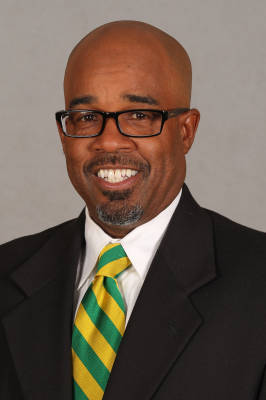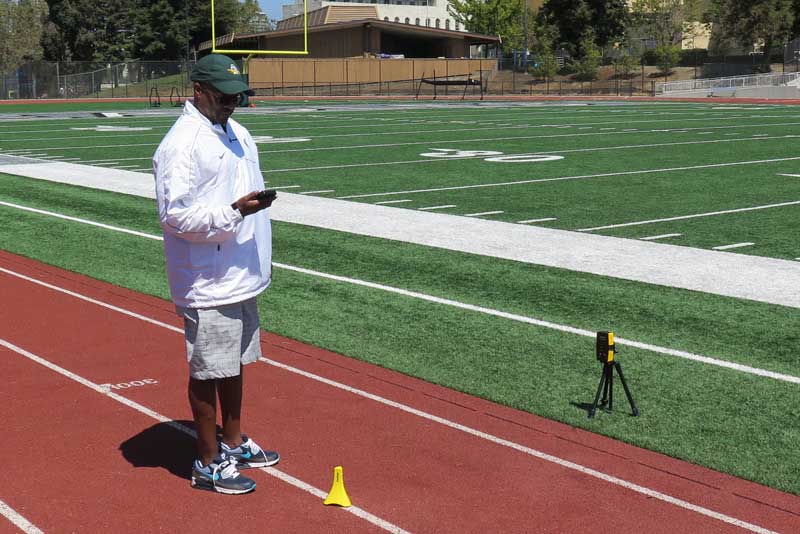
University of Oregon Sprints, Hurdles, and Relays Coach Curtis Taylor
Influence of Tony Wells
Freelap USA — A lot of Tony Wells’ philosophy is still influencing many coaches in the US. Tony was very detailed and measurement based, and some of the intensities and output he programmed into his training was legendary. Could you share in detail some of your thoughts on how you plan practices to meet safe levels of intensity? Fatigue and injury are obvious parts of sprinting and you have had great success with developing athletes in the sprints.
Coach Taylor — One of the things that Tony stressed to me over the years and that was always a subtle context in any of his clinics or presentations was the issue of progression and compatibility. If the intensity is extremely high, then the volume must, initially, be extremely low and all the other exercises done during that particular training session and/or that particular microcycle should be compatible with the major emphasis of that session or microcycle. A typical training cycle for a particular task could begin with as low as 1 repetition or 1 set per training session. Example: our hurdle hop/depth jump progression for the fall/winter General Prep/Pre Comp phase is similar to the following.
3 weeks lower leg leg complex strengthening (ankling, walking drills, in place mini jumps, hops, etc…), followed by 1 week recovery beginning with 1 set of each exercise, 2 x per week, progressing by 1 set of each exercise per week. Followed by 4-6 weeks of hurdle hops, beginning with 1 set 2 x per week, and increasing 1 set per week followed by 1-2 weeks recovery. Building up to Depth Jumps off boxes over hurdles beginning with 1 set 2 x per week and building up to 4-6 sets. The adaptation and recovery process is built in to reduce the chance of injury, beginning with exercises that strengthen the system and support the ultimate and most difficult goal, which would to be to successfully navigate the depth jumps while decreasing the possible risk of injury. I feel that if you prepare properly and limit the early volume, you substantially decrease the risk of injury with high intensity work.
Carl’s Take — The most important part of monitoring is managing the volumes, intensities, and modality progressions according to the best coaches. I have made the mistake of focusing too much energy on monitoring fatigue instead of managing power development. Straightforward record keeping of practice and observations can allow any coach to ensure recovery is programmed properly and the above progression is elegant and effective.
Plyometrics
Freelap USA — Plyometrics are a popular topic when sprint coaches are looking to enhance athletes but each sprinter is unique. How do you tailor the exercises or is this necessary at all? Some believe general plyometrics help everyone and some are very precise in what they include. Any guidance here?
Coach Taylor — I believe general plyometrics help everyone, IN GENERAL. I feel that to help, though, a coach must be diligent in discussing the goals of the exercise and not to just do them to do them. I’ve seen far too many athletes jumping up, down, on or over things in an incorrect fashion. Because sprinting is specific, though, I include only a small group of plyometric exercises that I feel are specific and transfer well to sprinting. Short Jumps (SLJ, 3 x J, 5 x J) which I feel, and some research has demonstrated, are specific to aiding in block starting/acceleration and the beginning of maximum velocity, Long Jumps (10 x bounds and speed bounds), which have been shown to assist in developing elasticity which helps with top end speed and correlates with stride length improvements. We also use Russian Hops, which helps with proper heel recovery, and promotes single leg strengthening and coordination. Obviously, we use hurdle hops and depth jumps which helps to decrease ground contact time and increase stiffening of the ankle joint. The one thing that Tony and I went over, ad nauseam, lol, is that sometimes when looking at an athletes faults and looking to change them and focusing on that, and neglecting their strengths, you can ruin the athlete. So in tailoring a plyometric/jump program to an individual, you want to make sure that what you are doing is not taking away from what they do well, UNLESS, what they do well is ultimately a limiting factor. So in knowing what you get from each type of jump/plyo exercise you use, you can either limit or increase the usage of it to accommodate the individual athlete. Some athletes have a frequency problem and would benefit from more exercises that focus on decreasing ground contact time and some have a stride length problem, and would benefit more from jump/bounding/power generating exercises that would improve their ground forces.
Carl’s Take — Stride Length and Stride Frequency are popular topics and the idea of putting more power into the ground will resolve issues to both the length of displacement of the center of mass (or the contact length) or the stroke rate (how many strides per second) is far more complicated than simple math. The issue is some athletes will improve speed by keeping things compact and reduce braking forces, thus increasing turnover without reducing stride length much or at all. Some athletes will get more force earlier on foot strike but appear longer because toe off is slightly delayed from unique anatomical reasons such as foot strike patterns. With maximal speed being 0.080 seconds, what is happening at 25 miles an hour and at 0.001 to 0.065 is extremely difficult to breakdown even with 200 frames per second video, and different force plate technologies don’t share the big picture. While such tiny differences are interesting, the normative ranges are common and we are not seeing much difference between what the 1980s produced and what we are seeing now. Everyone is unique, and much of this falls into place naturally with good general and specific development.

Coach Taylor reviews splits on the Freelap Pro Coach timing system.
Consistent Block Starts
Freelap USA — Consistent starts are vital to the short sprints and you practice starts purposely and with great care with your sprinters. What do you believe is key to having consistent starts in meets besides getting more practice starts during the week? Do you have some key details that separate your program from the approach of just getting them done?
Coach Taylor — Obviously, as you stated, the key to getting more consistent starts is to do more starts, and just as obviously, there is a limit to the number of quality starts you can get in in a practice. That being said, one of the things I stress to my athletes is to make your starts quality starts and not just do them just to do them. I always say that if we do 10 starts in practice (it’s rare if ever we would do that many) and we do 4 right, then we have a 40% success rate and a 40% chance you will get a successful one in the meet. I try to stress that we need no less than 90% of successful starts in practice. Now the question is what is a successful start? For us, we have a list of things that we start with in the fall: block rituals, cueing, acceleration lines, cutting the ankle, full extension, arm sweep, back block cueing, elbow up, etc… that they have to learn and learn in order. The good thing about that is that when they learn it fully, they can take it to the starting line and go over that prior to the race mentally and it eventually, it becomes automatic. The bad thing is that before it becomes automatic, it becomes a sort of a “paralysis by analysis” type of thing in which they are going over all the details of the start and acceleration in their head and are too slow executing it. I’m always willing to risk that early in an athlete’s career because in the long run, once they make it autonomic, they will see much improved results.
Carl’s Take — Practicing starts is an entire set of questions but the above information is excellent and I think we need more coaches to share their thoughts on block practice more than block biomechanics. To develop a good start, many of the best coaches share the system of how they transition to sterile practice environments to transitioning to big meets. I like doing starts in groups when athletes are ready or you will get a lot of practice performers and meets will be humbling Many coaches have a checklist of items, such as the criteria and milestones suggested by coach Taylor, to help show progress to such a brief part of the event. I suggest a basic checklist before moving on to something more lengthy.
Conditioning and Recovery
Freelap USA — Conditioning and recovery running via tempo runs are very controversial. Some say that active recovery with grass running and lower velocities help long term adaptations to the body such as capillary density and stiffness to the lower limbs. Others are worried about fiber type changes and hormonal problems with doing too much. What are your ways to keep 100-200 meter athletes fit so they can peak later during outdoors? Does conditioning outside body composition matter?
Coach Taylor — We do some type of recovery running/conditioning on both the grass (barefoot if possible) and the track. For us, there MUST be a technical component with them and I won’t do any more than 9 of those total if the distance is 100-120 m or less and no more than 4 if the distance is over 120 m. For short sprinters, I wouldn’t go over 180 m for one run. On the track we may go up to 180 m as a build up in with cones placed at 30 m increments, starting up with ankle over knee and picking up the pace at each cone. The focus is on finishing posture and technique. None of these runs start over 50% of maximum velocity, and these are always done on light/recovery days. This will add to some stiffness and some capillary density, but not as much as other exercises that you could select so I’m not counting on it for those things. I’m sure if your volumes of these would be higher it could affect the fiber composition. We do a ton of strength endurance during the fall: hills, straight leg bounds, lifting complexes, along with speed and speed development complexes. I try to peak my speed twice, once in the winter and again in the early part of the spring. After each I try to stack on specific endurance to extend that speed out. So generally, after indoors, we go down for a couple of weeks, touch on all of the exercises from the fall general prep and go back to basic speed development, followed by specific endurance and use the meets to get the specific endurance and race modeling that you need. That should provide all the fitness you need. We don’t do any outside body conditioning except for maintaining the weight room work.
Carl’s Take — It’s interesting to see how much different programs do with volumes of running for fitness and how that fitness may prepare a body to handle recovery specifically for the season. Active recovery is constantly talked about but with so many systems involved we can’t forget that the muscular system breaks down and the amount of easy running, as well as the velocity, needs to only sufficient. A drug free hormonal system can’t support inflated running volumes, and coaches must find just the right amount of running to help both the acute and long term changes.
Weight Training
Freelap USA — Weight training is another big discussion with coaches and some elect to have exhaustive and specific programs and some barely include any. What has changed the most in your thinking over your career and what are you doing differently this year to what you did your first few years?
Coach Taylor — My biggest thing about the weight room is that less is more. Weight training by nature is damaging to the muscles and athletes being sore during the season is not helpful. I’ve cut back to two days a week in the weight room, a minimum of 72 hours to recover and I try to keep ALL exercises during the indoor and outdoor season to under 6 repetitions per set per lift. I’m much more of an activation potential kind of a guy, less reps(1-3), approaching 90%+ of maximum, with a built in progression and mandatory increases at specific periods. Achieve maximum strength numbers in core lifts (deadlifts, squats, power cleans from the floor) during fall/winter then as the season approaches and during the season, work their derivatives (the explosive lifts: snatch, clean and jerk, push press, hang clean, jump squats, etc…) at 60% or below of the maximum associated lift(s) while still occasionally touching on the maximum strength. As Tony would say, you gotta cut the fat out of your training!
Carl’s Take — Fall core lifts (bar work from the floor) and migrating to more shorter range of motion work may be less taxing to the body. The polish style method of using elevated blocks to facilitate recovery is a great way to transition to outdoors when the work increases on the track according to many coaches. I am seeing a trend systemically with coaches going back to general movements such as the jerk and push press and even using jump squats for power development. In contrast to LSU bodybuilding methods, all of the lifts below are less than 6 reps showing that a wide range of philosophies are successful and coaches should choose what works for them.
Editor’s Note — For many coaches, the name Tony Wells simply sparks an image of a wonderful and giving man from Denver Colorado. Many of us have been influenced by his approach to sprints and sadly he passed away and left a big hole in elite sprinting and in many of the hearts he touched. We would like to dedicate this interview to the man and wish to thank Coach Taylor for keeping his memory alive by acknowledging his influence and by sharing some great information.
Please share this article with others who may benefit.
[mashshare]


These interviews are great! Very valuable and interesting information
Great Stuff!
This was a very good article, I picked up training techniques by just reading this article.
What are ankle complexes?Lifting complexes? And Speed Development Complexes?
The answer to that question is a little more than can be posted in a comment box. If you email me I can give you a more thorough answer. Good question, though!
A very insightful article, but do you handle the community college athlete who decides to start train seriously the week before the conference championships? LOL not that you have ever had to deal with this
Coach Taylor,
Can i get the some information on ankle,lifting and speed complexes PLEASE…. I,am A track coach in Alabama I would love that information…Thank you for your help and what you do for the kids…. Also, I have a guy that is in 10 grade.. His 60m 6.70 60mH 8.00 110H 15.00 300H 39.00.. His name is Hunter Appling.. Hunter has a 25 ACT already.. High school is West Point High school in Cullman,Al.. Good luck on rest of the season
If you are interested in Tony Wells training videos, try contacting Tony Veney, USA track Field Coach or Carol Smith Gilbert at at Southern Cal. They were his students. If that doesn’t work i have most of his training material.
YES IM VERY INTERESTED
Yes l am ,interested in
Toney Wells videos.
I am very interested in obtaining the training videos.